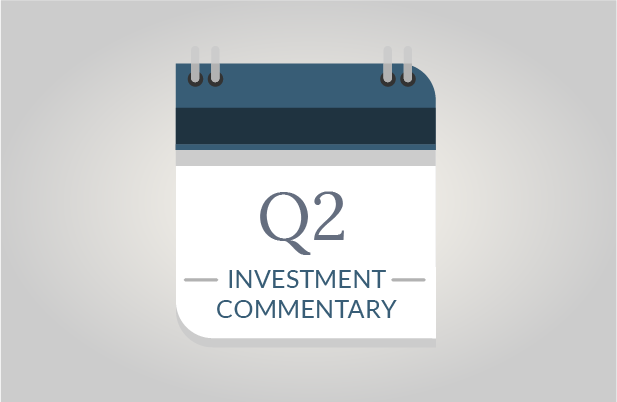SageVest Wealth Management’s latest quarterly commentary is now available. Highlights include:
– Stocks posted the best first half of the year since 1997.
– The S&P 500 climbed to new record highs.
– Interest rates plummeted and bond prices soared as the Fed hinted at lowering the federal funds rate.
A Celebratory First Half Of The Year
Whether you’re invested in stocks, bonds or a mixture thereof, there was much to rejoice about in the first half of the year as stock losses incurred at the end of 2018 were erased. Stocks and bonds alike posted returns that are impressive for a full year’s timeframe, let alone a short six months. The S&P 500 rose an impressive 18.5%, and the Barclays Aggregate Bond Index was up an astonishing 6.1% as of June 30, 2019.
What’s interesting is that these returns present a bit of an anomaly, particularly lofty stock market returns. Risks escalated due to trade tensions, an inverted yield curve and a possible recession as global growth softened. Stocks are typically risk-off, meaning that they often decline when risks are elevated. However, stocks posted one of their best showings in history. Why? The long and short answer is interest rates and expectations that the Federal Reserve Board will be cutting interest rates.
At the halfway mark of the year, investors frequently question if the first half of the year will be indicative of the balance of the year. Markets seldom continue on a solid, steady trajectory, with a notable exception of 2017. As such, investors should always expect some level of volatility. We explore some of the topics on our minds and likely on yours as we enter the second half of the year.
The Global Trade Saga
Trade tensions have been an ongoing topic of concern among clients. Trade volleying persisted throughout the first half of the year, but we might have reached an inflection point on the heels of the quarter’s close. President Trump and President Xi of China recently met post the G-20 summit. While no deal was reached, they did strike an accord to stop imposing new tariffs.
This is a step in the right direction, and a moment to appreciate. However, it certainly doesn’t draw tensions to an end. We’re probably still some distance away from trade resolution with China, the second largest economy in the world. Wise investors should likely prepare themselves for a protracted, and possibly bumpy, path forward. This applies to the US-China trade discussions, as well as other trade discussions that are ongoing, or are yet to emerge, as global trade matters remain uncertain and strenuous.
Iran
Speaking of tensions, they are certainly rising with Iran. This is a significant geopolitical risk worthy of monitoring for many reasons, particularly the potential loss of life if military action ensues. However, while we don’t want to dismiss the importance of the situation, we do think it’s important to recognize that military actions have historically had less impact on the investment markets than one might expect. Hence, we certainly hope for a peaceful resolution, but at the same time are not overly anxious about a financial impact to client portfolios.
A Persistent Yield Curve Inversion
Another concern, and one that we raised last quarter, was the potential impact of an inverted yield curve – where short-term rates exceed those of the 10-year Treasury. An inverted yield curve has frequently been a precursor to a recession. The duration of a yield curve inversion is worthy of note, as the longer an inversion persists, the potentially more ominous it becomes. We feel it’s worthy to note that the yield curve remains inverted, yet only partially in the belly of the curve.
We also feel it important to note that not every historical inversion has begat a recession. Secondly, even if a recession ensues, not all recessions are created equally. In fact, some are over before the data evidencing a recession even surfaces in the headlines. Hence, this cautionary indicator should (as with most things) be taken with a grain of salt.
Interest Rates – A Driving Force
After an inversion of the yield curve in the first quarter, rates plummeted during the second quarter. The yield of the 10-year Treasury ended the quarter at 2.0%, while temporarily dipping even lower. Interest rates have moved swiftly as demonstrated by half-year bond returns, with the Barclays Aggregate Bond Index up 6.1% as of June 30th. Bond yields and bond returns move inverse to one another, meaning that as rates fall, bond prices rise.
Stocks also have a tendency to move inversely to interest rates. Stocks favor low interest rate environments for a host of reasons. Lower rates help to make financing cheaper, whether you’re a company or an individual. The easier and cheaper it is to buy things, the easier it is for the economy to grow and expand. Interest rates also serve as a discount factor for company earnings and profits, making each of which more attractive as rates decline. Additionally, the lower interest rates fall, the more attractive stock dividends and appreciation potential become.
In our eyes, falling interest rates were a primary driver of the second quarter growth. Why did rates fall? Two key reasons emerged: slowing global growth and an expectation that the Federal Reserve Board (Fed) will lower its benchmark short-term rate (the federal funds rate) to combat slowing growth.
The Fed opened the door to a possible rate cut in response to signs of global economic weakness at its June meeting. The markets (both the bond market and the stock markets) have now largely factored in at least one rate cut, if not several. All eyes are on the July Federal Open Committee (FOMC) meeting to see if the Fed moves forward in rapid order, and to what magnitude.
Don’t Fight The Fed
While one could say there’s a wall of worry that the markets are combatting, the Fed’s potential actions certainly warrant strong consideration.
There’s a well-known adage “Don’t fight the Fed”, coined by Martin Zweig. This statement suggests that the Fed is a dominant factor in
determining the direction of stock market performance, namely that falling interest rates are bullish for stocks, and conversely that rising interest rates are bearish.
It’s true that the stock market doesn’t like uncertainty, of which we have plenty, nor do stocks favor weak economic growth forecasts. However, the economy and the markets aren’t always aligned as evidenced by much of the past decade since the Great Recession. This period clearly taught us that the stock markets can soar despite a feeble economy. Global central banks lowered interest rates and engaged in quantitative easing to combat deflation and anemic global growth. These were worrying points that could ordinarily derail stock performance, yet stocks flourished due to an accommodative interest rate environment.
There’s no guarantee that a rate reduction by the Fed will prompt a continued stock market rally. However, at the same time, the potential impacts shouldn’t be discounted as investors could be left out of a continued bull market rally as a result.
Looking Forward
As we look to the second half of 2019, a lot hinges on the many variables constructing a prevalent wall of worry, as well as on the materialization of rate cuts. We remain optimistic, but also realistic, about what may or may not unfold. Our advice remains to hold a portfolio that protects you as needed to the downside while ensuring adequate growth exposure to enjoy the upside, which will hopefully perpetuate into the second half of the year.




